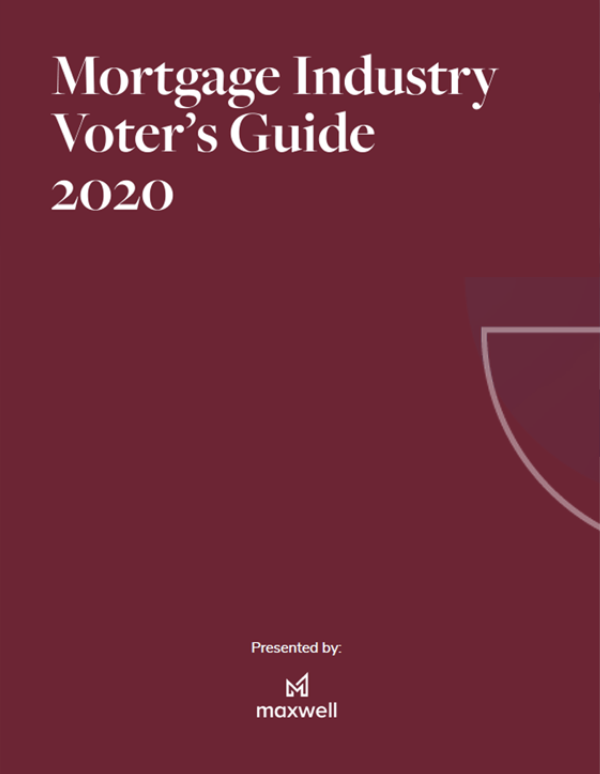What Will the Incoming Biden Administration Mean for the Mortgage Industry?

As Joe Biden moves into his role as President of the United States, the country as a whole anticipates change, and the mortgage industry is no exception. With all eyes on housing-related legislation emphasized by the Biden/Harris ticket, lenders wonder what a fresh start in the White House will mean for them in the coming months. From economic shifts to policy reforms, mortgage professionals can undoubtedly expect a new industry outlook to accompany the incoming Biden administration.
Rising interest rates
A projected rise in interest rates should come as no surprise. With interest rates at historic lows in the final quarter of 2020, there’s really nowhere to go but up.
The coronavirus vaccine is expected to normalize economic activity in the travel, lodging, and entertainment sectors, which should give lift to the general GDP. At the same time, firming inflation has the potential to lead to higher market-based interest rates. Based on data from the Obama era, analysts suggest that over the next year, interest rates could potentially peak around 3.2% or 3.44% for 30 year FRM on the high or “worst-case” end.
Of course, projections are speculative. Additional COVID strain outbreaks and the unknown recovery time for small businesses in every sector could keep rates lower than expected. However, most industry professionals doubt that we’ll see rates dip below what we’re currently experiencing at the beginning of 2021.
For lenders, rising interest rates could theoretically lead to a decline in new loan generation as the monthly costs of carrying a mortgage rise for borrowers, though the gradual increase doesn’t seem to be enough to realistically deter home purchases. More likely, the consumer push to refinance current mortgages will probably begin to slow down a bit.
Leveling home prices
Fueled by pandemic-driven urban sprawl, the housing market has seen remarkable resiliency and even growth in the past few quarters of 2020. A sellers’ market pushed home prices up, particularly in suburban locales.
But with hope for post-pandemic normalcy in the months to come, the National Association of Realtors (NAR) anticipates more balance in supply and demand, which will inevitably affect home prices. Where the median price is currently $303,000, the NAR projects a slight dip to $297,000 in the first quarter, then a subsequent return to normal growth models.
For mortgage lenders, home pricing is largely tied to appraisals. During his campaign, Biden made broad statements regarding the need for national appraisal standards and additional appraiser training, specifically in the valuation of homes in communities comprised primarily of people of color. As home prices level, appraisals could come under more scrutiny; lenders will do well to remain vigilant about new standards when requesting appraisals in the coming years.
Additional access for borrowers
Housing reform was one of the hallmarks of the Biden campaign and will likely be a priority for the administration. Anticipated new leadership for the Consumer Finance Protection Bureau (CFPB) and the Federal Housing Finance Agency (FHFA) could mean a focused and strategic implementation of Biden’s six principles for housing: affordability, stability, safety, accessibility, efficiency, and proximity.
During his campaign, Biden proposed a $640 billion investment in housing over the next 10 years. One part of that investment includes the initiation of a downpayment tax credit of up to $15,000 for first-time homebuyers. The credit is intended to make it easier for borrowers to jump that initial hurdle of homeownership by offering immediate assistance (rather than waiting until next year’s tax filing).
With the Georgia elections shifting the balance of power in the senate, housing experts consider this tax credit to be more likely to succeed in some measure or another. An additional stimulus package for individuals and small business is also expected. Even if existing home inventory remains low, these incentives could drive contractors to invest more in new builds in order to capitalize on buyers’ increased purchase power. Subsequently, new home sales––and mortgages––could rise in the third and fourth quarters of this year.
Biden also hopes to create a new public credit reporting agency under the CFPB, saying that the three major credit reporting companies are “rife with problems.” The public credit reporting agency would work toward the elimination of racial disparities and account for non-traditional data sources, which could boost credit scores. Better credit scores should, in turn, create better access to mortgages.
Fewer foreclosures
Biden plans to create a Homeowner Bill of Rights modeled after similar legislation enacted by Kamala Harris in 2013 in the state of California. Provisions within the California Homeowner Bill of Rights restrict and regulate foreclosure proceedings and expand the statute of limitations for prosecution of mortgage-related crimes.
A study out of UCLA suggests that anti-foreclosure laws in California not only dramatically decreased the number of foreclosures but also increased housing prices over projections. Analysts say the upward push on pricing results from two sources: 1) a containment of housing panic where foreclosed homes that are “priced-to-sell” depress other home prices in the market and 2) a limiting of the “disamenity effect” where foreclosed homeowners avoid home upkeep and therefore diminish the value of surrounding homes.
Assuming that the Biden administration establishes a national Homeowner Bill of Rights, the mortgage industry can expect more red tape when pursuing foreclosures. Considering that 3.5 million Americans are currently experiencing mortgage forbearance due to the pandemic, this legislation could seriously disrupt the market on two sides of the same coin. While loan recovery becomes more difficult, loan modifications may become more necessary.
Expanded or reinstated legislation
In the months to come, lenders will also want to watch for legislative changes that could affect the loan industry directly or indirectly. The following are some specific pieces of legislation that Biden has mentioned expanding or reinstating.
HFA Risk-Sharing
Biden wishes to reinstate the U.S. Department of Housing and Urban Development’s (HUD) risk-sharing rule, section 542(c). This rule allows HUD to share the risk of mortgages written for multifamily housing projects by state and local housing finance agencies (HFAs) in an effort to provide affordable rental options.
Community Reinvestment Act
Biden’s campaign promised an expansion of the Community Reinvestment Act to include not only oversight of banks but also of non-bank lenders and insurance companies. The goal of this expansion is to close loopholes that allow institutions to avoid investing in certain communities.
Good Neighbor Next Door Program
The Good Neighbor Next Door program offers assistance to first responders, educators, and other public servants who pursue housing in consistently impoverished communities or communities with fewer affordable housing options. Biden wishes to expand this program to offer additional downpayment assistance, increase the pool of qualified homes, and allow for low-interest rehab loans.
Maintained or increased regulation
Historically, Democrats tend to maintain or increase regulation in all markets, so there’s a good chance that the mortgage industry will see some additional government oversight. At this time, many mortgage professionals have eyes on the future of GSEs as well as discrimination litigation.
Conservatorship of GSEs
Trump had proposed a boost in capital reserves leading to the eventual re-privatization of Fannie Mae and Freddie Mac. However, Biden has made no reference to these government sponsored enterprises (GSEs). Some interpret the silence to mean that re-privatization is not a priority. Analysts anticipate that Biden will maintain government control of Fannie Mae and Freddie Mac, speculating that he might use GSE profits to fund affordable housing goals rather than focus on capital reserves.
Discriminatory practices
Under the Trump administration, discriminatory practice suits within the lending industry were difficult to litigate. A HUD rule established in 2020 required a preponderance of evidence in disparate impact cases, and the CFPB was limited in its ability to enforce settlements against discriminatory mortgages practices. Biden has claimed that his administration will enact regulations designed to protect consumers from discriminatory lending and will make discrimination prosecution easier.
Bottom line
The mortgage industry can expect both economic and regulatory changes as Joe Biden begins his term as President of the United States. Navigating a new industry landscape will require some flexibility from lenders at every level, but with proper support, future changes should be easily accommodated. For a more in-depth look at Biden’s proposed policies, as well as how Maxwell can offer support in a changing political climate, our voter’s guide ebook is a great resource.



